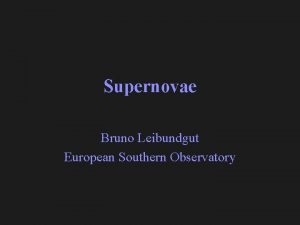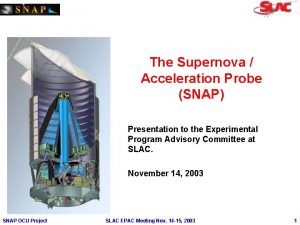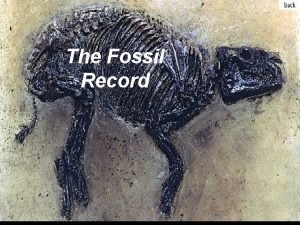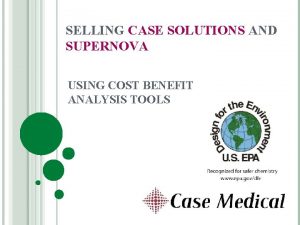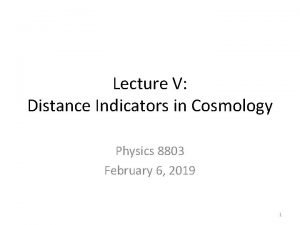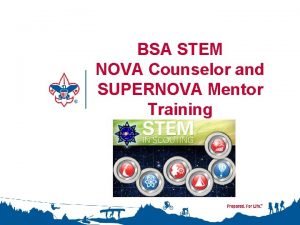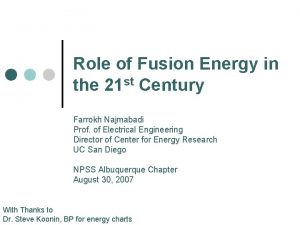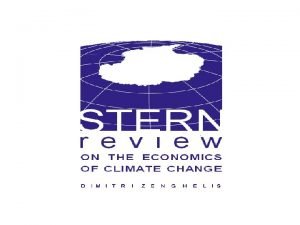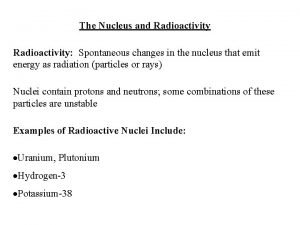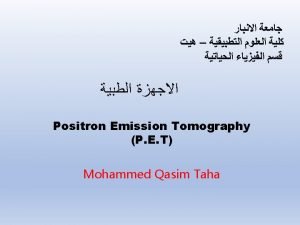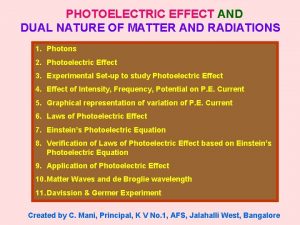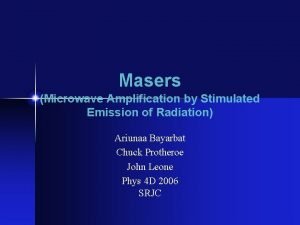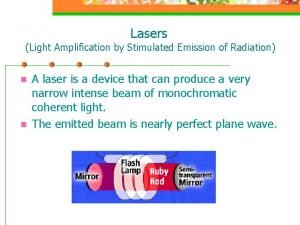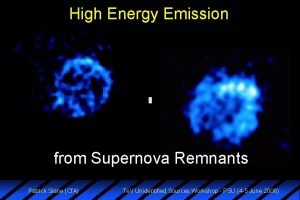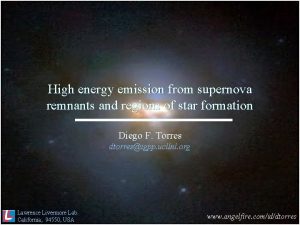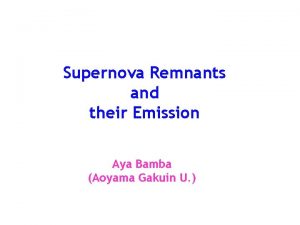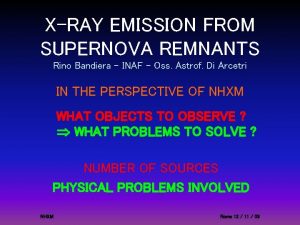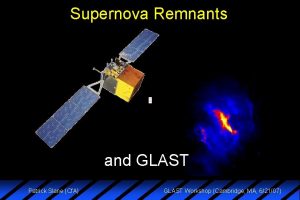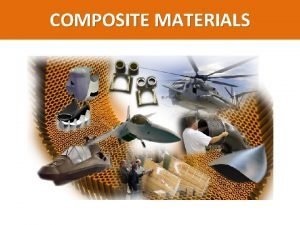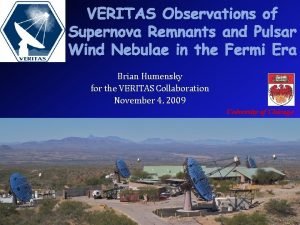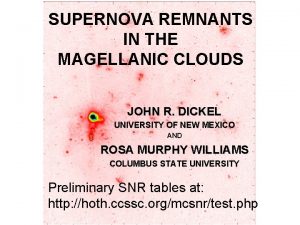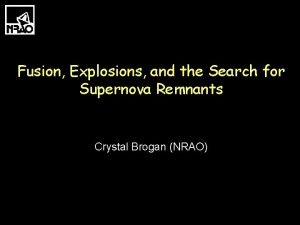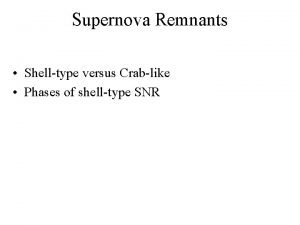High Energy Emission from Composite Supernova Remnants Patrick
























- Slides: 24

High Energy Emission from Composite Supernova Remnants Patrick Slane (Cf. A) Ge. V and Te. V Sources in the Milky Way Aspen, CO 2010

Composite SNRs • Pulsar Wind - sweeps up ejecta; shock decelerates flow, accelerates particles; PWN forms • Supernova Remnant - sweeps up ISM; reverse shock heats ejecta; ultimately compresses PWN Gaensler & Slane 2006 - self-generated turbulence by streaming particles, along with magnetic field amplification, promote diffusive shock acceleration of electrons and ions to energies exceeding 10 -100 Te. V Patrick Slane (Cf. A) Ge. V and Te. V Sources in the Milky Way Aspen, CO 2010

SNRs in Dense Environments • The expected 0 → flux for an SNR is W 28, W 44, Cygni, IC 443… where is a slow function of age (Drury et al. 1994) - this leads to fluxes near sensitivity limit of EGRET, but only for large n • Efficient acceleration can result in higher values for I-C -rays - SNRs should be detectable w/ Fermi for sufficiently high density; favor SNRs in dense environments or highly efficient acceleration - expect good sensitivity to SNR-cloud interaction sites (e. g. W 44, W 28, IC 443), and indeed these are detected Patrick Slane (Cf. A) 1 yr sensitivity for high latitude point source Ge. V and Te. V Sources in the Milky Way Aspen, CO 2010

SNRs in Dense Environments • The expected 0 → flux for an SNR is W 51 C Abdo et al. 2009 where is a slow function of age (Drury et al. 1994) - this leads to fluxes near sensitivity limit of EGRET, but only for large n • Efficient acceleration can result in higher values for I-C -rays - SNRs should be detectable w/ Fermi for sufficiently high density; favor SNRs in dense environments or highly efficient acceleration - expect good sensitivity to SNR-cloud interaction sites (e. g. W 44, W 28, IC 443), and indeed these are detected Patrick Slane (Cf. A) Ge. V and Te. V Sources in the Milky Way Aspen, CO 2010

SNRs in Dense Environments G 349. 7+0. 2 CTB 37 A • SNRs with maser emission are sources of Ge. V emission (Castro & Slane 2010) 3 C 391 Patrick Slane (Cf. A) G 8. 7 -0. 1 Ge. V and Te. V Sources in the Milky Way • Since composite SNRs are likely to be found in dense regions, one might expect Ge. V emission from the remnant itself Aspen, CO 2010

Evolution of a Composite SNR • SNR expands into surrounding CSM/ISM. In Sedov phase, • PWN expands into surrounding ejecta, powered by input from pulsar: • In principle, PWN can overtake SNR boundary - In reality, SNR reverse shock will first interact w/ PWN Patrick Slane (Cf. A) Ge. V and Te. V Sources in the Milky Way Aspen, CO 2010

Evolution of a Composite SNR • SNR expands into surrounding CSM/ISM. In Sedov phase, • PWN expands into surrounding ejecta, powered by input from pulsar: • In principle, PWN can overtake SNR boundary - In reality, SNR reverse shock will first interact w/ PWN Patrick Slane (Cf. A) • Treating evolution self-consistently, with rapid initial SNR expansion, and evolution of PWN and SNR reverse shock through common ejecta distribution reveals more details… Ge. V and Te. V Sources in the Milky Way Aspen, CO 2010

Evolution of a Composite SNR • Forward shock behavior (primarily, as far as we understand) determines -ray emission from the SNR - DSA, B 0, n 0 • Pulsar input plus confinement by ejecta determines -ray emission from the PWN - BPWN, Ee, reverse-shock interaction Patrick Slane (Cf. A) Ge. V and Te. V Sources in the Milky Way Aspen, CO 2010

Evolution of PWN Emission • Spin-down power is injected into the PWN at a time-dependent rate 1000 yr 2000 yr 5000 yr • Assume power law input spectrum: - note that studies of Crab and other PWNe suggest that there may be multiple components • Get associated synchrotron and IC emission from electron population in the evolved nebula CMB - combined information on observed spectrum and system size provide synchrotron inverse constraints on underlying structure and evolution Compton Patrick Slane (Cf. A) Ge. V and Te. V Sources in the Milky Way Aspen, CO 2010

Evolution of PWN Emission • Spin-down power is injected into the PWN at a time-dependent rate • Assume power law input spectrum: - note that studies of Crab and other PWNe suggest that there may be multiple components Bucciantini et al. 2010 • Get associated synchrotron and IC emission from electron population in the evolved nebula CMB - combined information on observed spectrum and system size provide synchrotron inverse constraints on underlying structure and evolution Compton Patrick Slane (Cf. A) Ge. V and Te. V Sources in the Milky Way Aspen, CO 2010

Broadband Observations of 3 C 58 Slane et al. 2008 • 3 C 58 is a bright, young PWN - morphology similar to radio/x-ray; suggests low magnetic field - PWN and torus observed in Spitzer/IRAC • Low-frequency break suggests possible break in injection spectrum - IR flux for entire nebula falls within the extrapolation of the X-ray spectrum - indicates single break just below IR • Torus spectrum requires change in slope between IR and X-ray bands - challenges assumptions for single power law for injection spectrum Patrick Slane (Cf. A) Ge. V and Te. V Sources in the Milky Way Aspen, CO 2010

Broadband Observations of 3 C 58 Slane et al. 2008 • Pulsar is detected in Fermi-LAT - to date, no detection of PWN in off-pulse data Patrick Slane (Cf. A) Ge. V and Te. V Sources in the Milky Way Aspen, CO 2010

Evolution in an SNR: Vela X La. Massa et al. 2008 • XMM spectrum shows nonthermal and ejecta-rich thermal emission from cocoon - reverse-shock crushed PWN and mixed in ejecta? • Broadband measurements consistent with synchrotron and I-C emission from PL electron spectrum w/ two breaks, or two populations - density too low for pion-production to provide observed g-ray flux - magnetic field very low (5 m. G) Patrick Slane (Cf. A) Ge. V and Te. V Sources in the Milky Way Aspen, CO 2010

Evolution in an SNR: Vela X de Jager et al. 2008 Abdo et al. 2010 • Treating radio-emitting particles as separate population, flux limits suggest detection of IC component in Ge. V band • AGILE and Fermi-LAT measurements confirm these predictions - apparent difference between main nebula and cocoon Patrick Slane (Cf. A) Ge. V and Te. V Sources in the Milky Way Aspen, CO 2010

Evolution in an SNR: Vela X Abdo et al. 2010 • Treating radio-emitting particles as separate population, flux limits suggest detection of IC component in Ge. V band • AGILE and Fermi-LAT measurements confirm these predictions - apparent difference between main nebula and cocoon • XMM large project to map cocoon and much of remaining nebula underway Patrick Slane (Cf. A) Ge. V and Te. V Sources in the Milky Way Aspen, CO 2010

HESS J 1640 -465 5 arcmin • Extended source identified in HESS GPS - no known pulsar associated with source - may be associated with SNR G 338. 3 -0. 0 • XMM observations (Funk et al. 2007) identify extended X-ray PWN • Chandra observations (Lemiere et al. 2009) reveal neutron star within extended nebula - Lx ∼ 1033. 1 erg s-1 Ė ~ 1036. 7 erg s-1 - X-ray and Te. V spectrum well-described by leptonic model with B ∼ 6 μG and t ∼ 15 kyr - example of late-phase of PWN evolution: X-ray faint, but -ray bright Patrick Slane (Cf. A) Ge. V and Te. V Sources in the Milky Way Aspen, CO 2010

HESS J 1640 -465 Lemiere et al. 2009 LAT 1 yr sensitivity • Extended source identified in HESS GPS - no known pulsar associated with source - may be associated with SNR G 338. 3 -0. 0 • XMM observations (Funk et al. 2007) identify extended X-ray PWN • Chandra observations (Lemiere et al. 2009) reveal neutron star within extended nebula - Lx ∼ 1033. 1 erg s-1 Ė ~ 1036. 7 erg s-1 - X-ray and Te. V spectrum well-described by leptonic model with B ∼ 6 μG and t ∼ 15 kyr - example of late-phase of PWN evolution: X-ray faint, but -ray bright Patrick Slane (Cf. A) Ge. V and Te. V Sources in the Milky Way Aspen, CO 2010

HESS J 1640 -465 • Extended source identified in HESS GPS - no known pulsar associated with source - may be associated with SNR G 338. 3 -0. 0 Slane et al. 2010 • XMM observations (Funk et al. 2007) identify extended X-ray PWN • Chandra observations (Lemiere et al. 2009) reveal neutron star within extended nebula - Lx ∼ 1033. 1 erg s-1 Ė ~ 1036. 7 erg s-1 - X-ray and Te. V spectrum well-described by leptonic model with B ∼ 6 μG and t ∼ 15 kyr - example of late-phase of PWN evolution: X-ray faint, but -ray bright • Fermi LAT reveals emission associated with source Patrick Slane (Cf. A) Ge. V and Te. V Sources in the Milky Way Aspen, CO 2010

HESS J 1640 -465 • PWN model with evolved power law electron spectrum fits X-ray and Te. V emission Slane et al. 2010 - Fermi emission falls well above model Patrick Slane (Cf. A) Ge. V and Te. V Sources in the Milky Way Aspen, CO 2010

HESS J 1640 -465 • PWN model with evolved power law electron spectrum fits X-ray and Te. V emission Slane et al. 2010 - Fermi emission falls well above model • Modifying low-energy electron spectrum by adding Maxwellian produces Ge. V emission through inverse Compton scattering - primary contribution is from IR from dust (similar to Vela X) - mean energy ( ∼ 105) and fraction in power law (∼ 4%) consistent w/ particle acceleration models Patrick Slane (Cf. A) Ge. V and Te. V Sources in the Milky Way Aspen, CO 2010

HESS J 1640 -465 • PWN model with evolved power law electron spectrum fits X-ray and Te. V emission Slane et al. 2010 - Fermi emission falls well above model • Modifying low-energy electron spectrum by adding Maxwellian produces Ge. V emission through inverse Compton scattering - primary contribution is from IR from dust (similar to Vela X) - mean energy ( ∼ 105) and fraction in power law (∼ 4%) consistent w/ particle acceleration models • Ge. V emission can also be fit w/ pion model - requires n 0 > 100 cm-3, too large for G 338. 3 -0. 3 Patrick Slane (Cf. A) Ge. V and Te. V Sources in the Milky Way Aspen, CO 2010

Probing Composite SNRs With Fermi • MSH 15 -56 is a composite SNR for which radio size and morphology suggest post-RS interaction evolution • Chandra and XMM observations show an offset compact source with a trail of nonthermal emission surrounded by thermal emission (Plucinsky et al. 2006) - possibly similar to Vela X • Good candidate for -rays, And… Patrick Slane (Cf. A) Ge. V and Te. V Sources in the Milky Way Aspen, CO 2010

Probing Composite SNRs With Fermi 1 FGL J 1552. 4 -5609 • Watch for studies of this and other such systems with Fermi Patrick Slane (Cf. A) Ge. V and Te. V Sources in the Milky Way Aspen, CO 2010

Questions • Is stage of evolution a crucial factor in determining whether or not a PWN will be a bright Ge. V emitter? In particular, is the reverse-shock interaction an important factor? • Are multiple underlying particle distributions (if they indeed exist) physically distinct? If so, what do they correspond to? • How can we best differentiate between PWN and SNR emission in systems we can't resolve (in gamma-rays)? Patrick Slane (Cf. A) Ge. V and Te. V Sources in the Milky Way Aspen, CO 2010
 Bruno leibundgut
Bruno leibundgut Romeo and juliet vocabulary act 5
Romeo and juliet vocabulary act 5 Deqms sdmp
Deqms sdmp Supernova acceleration probe
Supernova acceleration probe Evidence of evolution of remnants and impressions *
Evidence of evolution of remnants and impressions * Supernova
Supernova Supernova spectra
Supernova spectra Foam remnants
Foam remnants Supernova
Supernova Entologista
Entologista Supernova mentor
Supernova mentor Energy emission
Energy emission Energy emission
Energy emission Energy emission
Energy emission Moment of inertia composite shapes
Moment of inertia composite shapes Energy energy transfer and general energy analysis
Energy energy transfer and general energy analysis Energy energy transfer and general energy analysis
Energy energy transfer and general energy analysis Quantum foam
Quantum foam How did stanley meyer die
How did stanley meyer die Cobalt-60 nuclear decay equation
Cobalt-60 nuclear decay equation Symbol for beta particle
Symbol for beta particle Positron emission
Positron emission Einstein equation for photoelectric emission is
Einstein equation for photoelectric emission is Masers are microwave
Masers are microwave Define metastable state
Define metastable state
